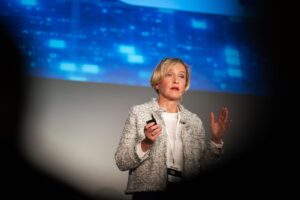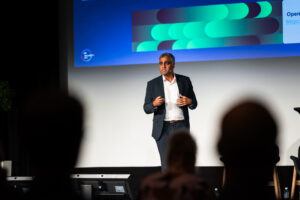Banking is a systemic business undergoing many concurrent changes. To keep up to date and gain a full picture of key developments is a definite must yet increasingly difficult to achieve. The industry is like a multistory building where looking in from one window reveals only a tiny part of the entirety. A narrow perspective might give an interesting and real picture but still lead to erroneous conclusions as you gain a wider perspective. A system cannot be driven or grown by optimising parts of it, it must be cultivated and engineered as a whole. The same is true as you try to shape a picture of the road ahead.
Nordic Banking Forum is on a mission to elevate banking and to do that we’ve introduced five landscapes that sketch an accurate picture around the industry fundamentals. The same fundamentals that not just shape the future of banking but the economy as a whole. No industry predicts the health of the whole economy better than banking.

As promised, this year’s event offered a truly wide perspective as we commenced the day with the Economic and Risk Landscape followed by Strategic and Business Landscapes before ending the day with the Digital Landscape.
The Economic Landscape addressed the new normal around higher inflation and interest rates. The good news delivered by Tuomas Välimäki of Bank of Finland and Johan Javeus of SEB was that inflation rates are falling rapidly and high employment is holding up, however the relatively dramatic change in higher interest rates can hide something worse underneath the time lags. Anna Asikainen of UBS introduced the idea that banks must treat climate risks alongside credit, market and liquidity risks.
Karoliina Pentti of OP Bank raised customer experience to the heart of strategic planning and execution as she set the tone for the Strategic Landscape as the first speaker. A bank only exists for its customers yet leading customer experience can only be successful if given a mandate from the top. Bringing the customer voice to the core of banking is not easy, but it’s hard to envision any future for a bank that doesn’t seriously aim to do so. Sara Mella of Nordea Bank also identified the power shift to customers and high personalisation experience expectations as leading industry trends for which all eyes must be on winning in digital banking. To do that you must reimagine relationship banking like Nordea does.

Arto Sorvoja of Kyndryl and Karli Kalpala of Digital Workforce positioned AI nicely as central to the success of any future proof banking strategy. Arto’s point about the war on talent only having started due to the acute shortage of AI/ML knowhow definitely hit home hardest. It will be most interesting to follow how banks take on the rapid upskilling challenges ahead. The final morning session certainly didn’t have any lower ambition level than previous sessions when Mikko Ayub and Erik Åkesson from BearingPoint gave glimpses to their upcoming white paper by addressing Big Tech’s foray into banking. The much anticipated disruption in banking 5 years ago didn’t happen through fintechs, but times have changed and banking is interesting from a big tech perspective. Unlike fintechs, big techs do not need to partner with banks to gain a foothold.
The Business Landscape addressed topics from composable banking through partner ecosystem by Leo Vaskelainen of Siili Solutions to Open Banking by Sarah Häger of Enable Banking and featured panels on banks use of alternative financing platforms and responsibility and profitability in consumer lending. Martti Hakala of Finland’s Savings Bank Group and Vesa Moisio of Tink gave an interesting view on how banks can help customers in financial distress. The idea of financial coaching is not new but has in no way been exhausted or become any less relevant. A bank account doesn’t have to be a dumb bank statement but a source of rich data for us people to take control of our economy. 
Proving how interesting modern banking truly is, the day was even further elevated as we reached the final session of the day with the Digital Landscape. Banking is built on data and trust and the only panel, moderated by Diana Tomingas of BearingPoint, raised the difficulty some countries like Finland have with sharing data between banks. The panel was able to pierce the surface of this complex topic but it is evident that here is a theme that needs revisiting. Almost ironically, Magnus Källhager of Kreditz was in his presentation able to prove the concrete monetary value of smart data utilisation in financing. The event and session came to a worthy end as Mats Persson Bergius of Lunar gave a sobering account of the state of neobanking and how banks – whether incumbent or neo – are all fintechs today.
The importance of a technological mindset in banking was heavily echoed in the Lead Keynote of Nordic Banking Forum 2023 delivered by Prag Sharma the Global Head of Artificial Intelligence of Citi Bank who laid out the endless possibilities AI brings banks and thus proved that the way to lead tomorrow’s bank does look significantly different today than say 2 years ago.
The team at Nordic Banking Forum has already commenced the building of next year’s agenda with the simple aim of making it better year after year. All you have to do is save November 28th 2024 in your calendars and hold on to your hat as an industry we’re bound to see some real highs and lows again.
Last but certainly not least our final word and acknowledgement goes to the always inspirational and enthusiastic stage host Teppo Havo of Danske Bank who made the stage a fun place to be for speakers.
See you all next year!
Ola Sundell


